The Intel Skylake-X Review: Core i9 7900X, i7 7820X and i7 7800X Tested
by Ian Cutress on June 19, 2017 9:01 AM ESTBenchmarking Performance: CPU Office Tests
The office programs we use for benchmarking aren't specific programs per-se, but industry standard tests that hold weight with professionals. The goal of these tests is to use an array of software and techniques that a typical office user might encounter, such as video conferencing, document editing, architectural modelling, and so on and so forth.
Chromium Compile (v56)
Our new compilation test uses Windows 10 Pro, VS Community 2015.3 with the Win10 SDK to combile a nightly build of Chromium. We've fixed the test for a build in late March 2017, and we run a fresh full compile in our test. Compilation is the typical example given of a variable threaded workload - some of the compile and linking is linear, whereas other parts are multithreaded.
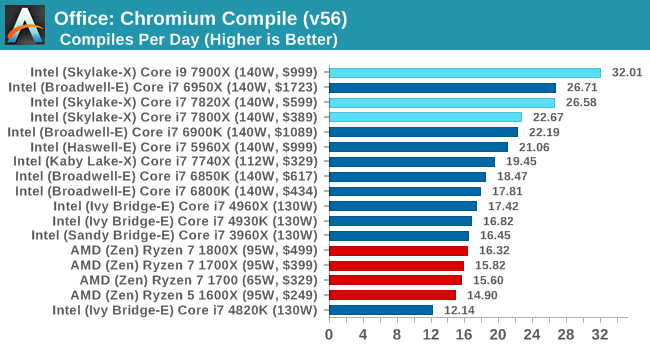
PCMark8
Despite originally coming out in 2008/2009, Futuremark has maintained PCMark8 to remain relevant in 2017. On the scale of complicated tasks, PCMark focuses more on the low-to-mid range of professional workloads, making it a good indicator for what people consider 'office' work. We run the benchmark from the commandline in 'conventional' mode, meaning C++ over OpenCL, to remove the graphics card from the equation and focus purely on the CPU. PCMark8 offers Home, Work and Creative workloads, with some software tests shared and others unique to each benchmark set.
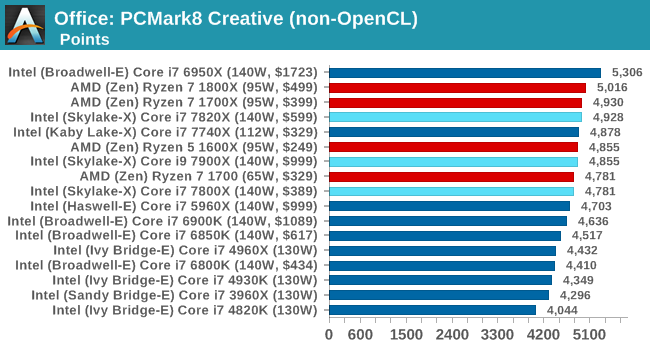
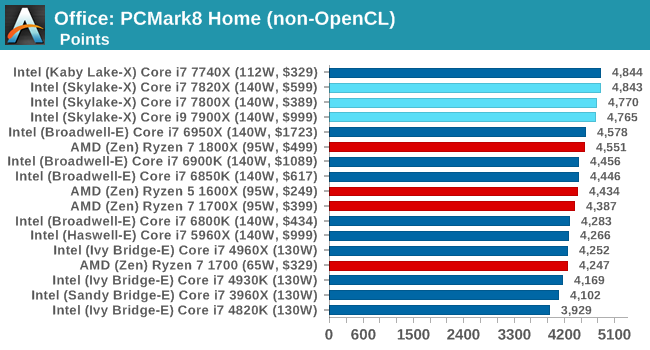
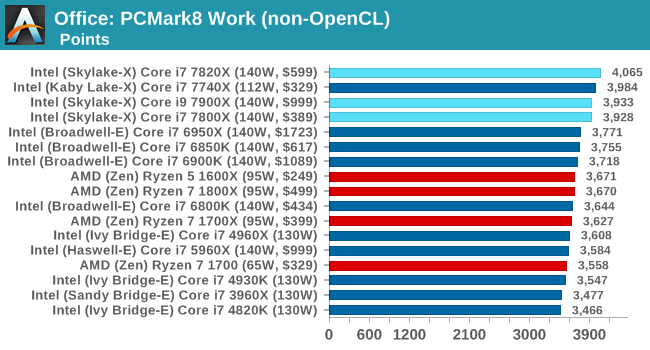
SYSmark 2014 SE
SYSmark is developed by Bapco, a consortium of industry CPU companies. The goal of SYSmark is to take stripped down versions of popular software, such as Photoshop and Onenote, and measure how long it takes to process certain tasks within that software. The end result is a score for each of the three segments (Office, Media, Data) as well as an overall score. Here a reference system (Core i3-6100, 4GB DDR3, 256GB SSD, Integrated HD 530 graphics) is used to provide a baseline score of 1000 in each test.
A note on context for these numbers. AMD left Bapco in the last two years, due to differences of opinion on how the benchmarking suites were chosen and AMD believed the tests are angled towards Intel processors and had optimizations to show bigger differences than what AMD felt was present. The following benchmarks are provided as data, but the conflict of opinion between the two companies on the validity of the benchmark is provided as context for the following numbers.
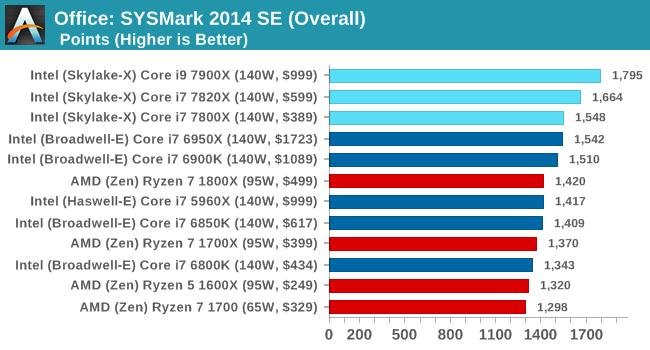










264 Comments
View All Comments
Einy0 - Monday, June 19, 2017 - link
Ian, I stand corrected and apologize. I think I allowed a previous poster's anger affect my thoughts on the subject. I'm still very confused as to why you would not publish results on both platforms while including a note in regards to gaming performance. Not that these chips are for gaming but many of us use our PCs as an all purpose computing platform and gaming is frequently included in the mix.Ryan Smith - Monday, June 19, 2017 - link
"I'm still very confused as to why you would not publish results on both platforms while including a note in regards to gaming performance. "1) Lack of time. The most recent BIOS update came close to the launch, and we haven't yet had enough time to fully validate all of our data.
2) Right now gaming performance is all over the place. And with Intel doing pre-orders, by the time you got your chips there's a good chance there will be another BIOS revision that significantly alters gaming performance.
Gothmoth - Tuesday, June 20, 2017 - link
the whole article feels rushed to be honest.there is basically no talk about the insane powerdraw and temps when overclocked.
jardows2 - Monday, June 19, 2017 - link
Let me give you the conclusion ahead of time. If you are buying a gaming chip, buy the i7-7700K.These are not gaming chips, they are work chips that can do gaming. It's like buying a 1-ton diesel truck, and wanting to floor it at the stoplight. It'll do it, but a Mustang or Camaro will do that better. The truck will be able to haul pretty much anything, that the pony cars will blow their transmissions on.
Ryzen, on the other hand, is all AMD has, and so gaming results are very relevant to the discussion.
prophet001 - Monday, June 19, 2017 - link
^ ThisHurr Durr - Monday, June 19, 2017 - link
I`d rather wait for the next iteration, whatever Lake that was. Hopefully 6 cores will step down into the mainstream, and then there is 10 nm.koomba - Thursday, July 6, 2017 - link
How.many.times.does.it.have.to.be.said? They did NOT post gaming benchmarks on their first Ryzen review either! You are seriously at least the 10th person who has come on here spouting this COMPLETE falsehood, and using it to bash this site or claim some kind of bias.Please do some research before you just talk nonsense and base your entire argument around something that isn't true.
Gasaraki88 - Monday, June 19, 2017 - link
Thank you for this article. I knew I could count on Anandtech to write a detailed article on the new Intel cpus, how everything on them worked, like the caches and turbo core 3.0, etc. not just benches.marcis_mk - Monday, June 19, 2017 - link
Ryzen R7 1700 has 24 pci-e lanes (20 for PCI-E dGPU and 4 for storage)Ian Cutress - Tuesday, June 20, 2017 - link
AMD has a tendency to quote the sum of all PCIe. We specifically state the PCIe root complex based lanes for GPUs. Ryzen has 16 + 4 + 4 - root complex, chipset, IO. Threadripper has 60 + 4: root complex(es) and chipset. Skylake-S has 16 + 4 - root complex, DMI/chipset. Etc.